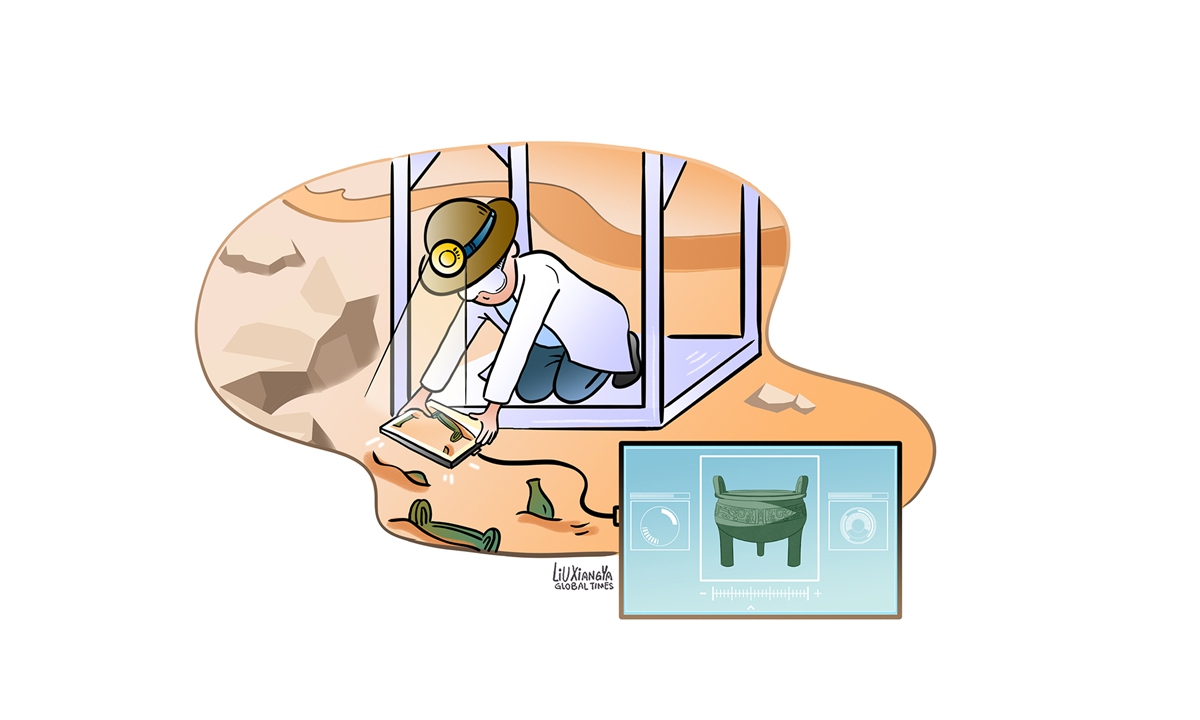ARTS / CULTURE & LEISURE
AI can boost archaeological research, relic protection

Illustration: Liu Xiangya/Global Times
A few days ago, a Chinese expert predicted that in the future artificial intelligence (AI) technology will be applied to archaeological research and help China in international exchanges in this field and promote its path to modernization.Gao Xing, a researcher with the Institute of Vertebrate Paleontology and Paleoanthropology, Chinese Academy of Sciences, delivered a report in a conference in North China's Hebei Province, where he outlined his interpretation of scientific archaeology, and its relationship with traditional archaeology.
It is the advanced stage of archaeology. Through previous excavation and studies of historical relics, it is a scientific method used to discover, deduct and interpret the laws of human society, and keep improving discoveries by accepting inquires and frequent tests.
AI and archaeology may sound trendy and inaccessible, but it is only the latest topic in Chinese archaeology circle which was recently applied to some of the cultural relic restorations.
At the newly built Sanxingdui Museum in Southwest China's Sichuan Province, a 2.5-meter-tall cultural relic integrating the cultures of the Sanxingdui site and the Xia (c.2070BC-c.1600BC) and Shang (c.1600BC-1046BC) dynasties, has attracted the attention of visitors.
Called the Sacred Bronze Statue with Human Face and Bird's Feet, it features a human-bird combined body with protruding eyes and fangs.
The artifact was restored through great effort as it was excavated from different sacrificial pits.
Concerned about the safety of its structure, archaeologists thought it would be almost impossible to assemble the pieces together.
So they took advantage of AI and 3D printing to match the various pieces and recreate a relatively complete form of this national treasure.
This technological achievement has broken the barrier between traditional archaeology and science, and it allows traditional archaeologists to embrace technological analysis in their research.
Meanwhile, they will become familiar with the methodological system of traditional archaeology.
In terms of the barrier, it was formed because when Chinese archaeology was established it was too early to separate different disciplines, resulting in traditional archaeologists' lack of understanding and interest in scientific analysis.
Meanwhile, technological staff are deficient in professional archaeological knowledge. So it is good to learn that today many institutions of higher learning have established technological archaeology departments.
This is not only interdisciplinary interaction, but sustainable and consistent with the Chinese archaeological development.
The combination of science and archaeology has a potential to develop in China. Why is this?
First, China possesses abundant historical materials, providing inexhaustible resources for study. Second, China's philosophy of sustained scientific innovation and development offers substantial wealth to scientific archaeology.
For example, an archaeological shelter and equipment independently innovated by Chinese archaeologists have acted as "a handy pen" to help with their work. Third, technological archaeology is sure to become an international trend in the future. But this is only a small goal in applied technological archaeology as it is more important for China to establish its own "modernized archaeological style," Yang said.
Therefore, AI technology will digitize archaeology, help set up a clear and complete structure in this field and promote archaeological integration between China and the world.
AI can also help with archaeological investigation, excavation, recording, data analysis and even thesis writing. In addition, it can extract information from enormous amounts of data and make it more standardized and objective, and Chinese archaeological results can also be shared with peers in other countries.
Chinese archaeology will be redefined in the future and become an important branch of international archaeological science.
Aside from traditional disciplines, it will established a new one - applied archaeology that runs parallel to the former and is used in cultural heritage protection. Of course, AI cannot replace human beings, but it can boost China's scientific research in different fields and promote Chinese modernization.


